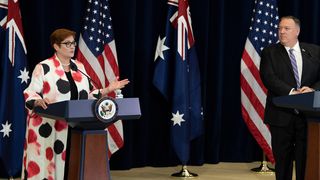Amid the pandemic and intensifying strategic competition, the Australia-US alliance is working to adapt to myriad Indo-Pacific challenges and provide critical health security and defence support to our partners.
That’s the key message from the AUSMIN consultations in Washington. Its deliverables point to Australia’s growing role within the alliance as a major contributor to the regional order, as well as the dividends and limits of our efforts to draw the Trump administration out of its “America First” mindset.
By far the most important initiative the alliance offered up was its unprecedented focus on health security and the region’s COVID-19 recovery. A detailed health security statement covered everything from co-operation on infectious diseases and pandemic preparedness to strengthening health services, vaccine development and the delivery of medical supplies.
By far the most important initiative the alliance offered up was its unprecedented focus on health security and the region’s COVID-19 recovery.
Canberra’s fingerprints are all over it, and it is a testament to the creative policy thinking that Australia filtered into the planning process. It is important because these initiatives are what the region needs and offer a pathway to restoring Washington’s damaged reputation as a humanitarian leader and rebuilding its soft power. This is central to its success in the US-China competition for influence.
The US and Australia firmly restated their concerns over China’s growing use of coercive statecraft and outlined a commitment to take enhanced actions to deter and defeat it. This will involve bilateral co-ordination on countering Chinese disinformation and increased maritime co-operation, capacity building and other forms of direct support to help Southeast Asian and Pacific nations safeguard their sovereignty and resilience.
As the 2020 Defence Strategic Update makes clear, Australia’s growing defence contributions are motivated by our interests in bolstering a favourable balance of power and recognition that the US can no longer uphold the Indo-Pacific order itself.
If the alliance is beginning to transform into a mechanism for collective deterrence, then Canberra and Washington need to explore where our overlapping but distinct strategic interests enable common thresholds for action, co-ordinated military strategy and combined contingency planning.
This makes AUSMIN’s unveiling of a new force posture working group all the more significant. If the alliance is beginning to transform into a mechanism for collective deterrence, then Canberra and Washington need to explore where our overlapping but distinct strategic interests enable common thresholds for action, co-ordinated military strategy and combined contingency planning. And we must do this in co-ordination with regional partners, which it was encouraging to see featured prominently in the joint statement.
Seamless defence industry collaboration between the US and Australia is also needed to optimise the alliance for this future collective role. But on this front AUSMIN didn’t make as much progress as hoped.
Beyond improving our capacity to co-produce platforms like the Joint Strike Fighter, we have more pressing needs such as developing in Australia a sovereign manufacturing capability for advanced guided weapons and munitions.
An integrated defence industrial base would see the US work with Australia to build this alliance-empowering capability. An Australian-based ability to build munitions would bolster our capability to be a strategic actor in our region, strengthen the credibility of our conventional forces, and enable us to play a more central role in supporting partners on the frontline of Chinese coercion.







